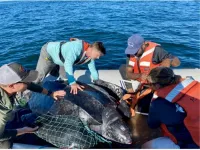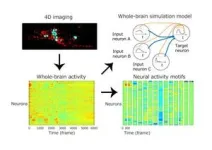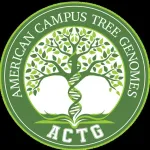(Press-News.org) A new study led by a team of marine scientists at the University of Miami Rosenstiel School of Marine, Atmospheric and Earth Science and the National Oceanic and Atmospheric Administration Southeast Fisheries Science Center, provides groundbreaking findings that offer insights on the migration and foraging patterns of leatherback sea turtles along the Northwest Atlantic shelf.
Scientists have known that leatherbacks commonly swim from the South and Mid-Atlantic Bights during the warmer months to reach feeding areas near New England and Nova Scotia, Canada where food is plentiful. They migrate southward again when water temperatures drop during the winter. But questions still remained about where the turtles went in between, and what they were doing along the way.
The study, published in the Journal Frontiers in Marine Science conducted over several years offers unique insights into the utilization of the U.S. coastline by these majestic creatures, challenging previous assumptions and emphasizing key conservation implications.
"Our findings signify a paradigm shift in understanding leatherback turtle behavior along the U.S. coastline,” said Mitchell Rider, a research scientist at the Rosenstiel School’s NOAA Cooperative Institute for Marine and Atmospheric Studies and a lead author of the study. “By highlighting key foraging grounds and migration patterns, we aim to inform targeted conservation strategies to safeguard the future of these magnificent creatures."
Where the Leatherbacks roam
The research involved the tagging and monitoring leatherback sea turtles (Dermochelys coriacea) off the coasts of Cape Cod, Massachusetts and Beaufort, North Carolina. Between 2017 through 2022 the team successfully tracked 52 leatherback sea turtles, using advanced satellite tags capable of recording location, depth, and temperature data. Applying the tags involves finding and capturing the leatherback turtles, which can weigh several hundred pounds—a challenging task. The scientists were able to track and learn where the turtles go and the behaviors they exhibit during their migrations.
The waters off Cape Cod and Nantucket promote a high abundance of jellyfish in the late summer and early fall, which the leatherbacks appear to be taking advantage of. The scientists observed some of the leatherbacks tagged along Nantucket Shoals, stayed in the area for weeks to months after tagging before migrating back south.
In the Mid-Atlantic Bight, the team inferred that there is food availability, given the high number of leatherbacks that displayed feeding-like behavior year after year. However, the team noted the lack of research on prey distributions in this area, and further observations for leatherbacks would benefit by returning to the site to deploy camera tags to determine what the leatherbacks are feeding on.
The South Atlantic Bight appears to support several stages of the migration cycle: nesting, post-nesting foraging, and overwintering. Not as many leatherbacks frequented this area, but the ones that were tracked displayed feeding-like behavior especially along the continental shelf ridge. Previous research in the area indicates that blooms of cannonball jellyfish occur nearshore in the South Atlantic Bight primarily during the spring, which coincides with leatherbacks overwintering and nesting stages of their migration cycle.
“Our study revealed a significantly higher utilization of the U.S. coastline by leatherbacks, particularly along regions of the Mid-Atlantic Bight, South Atlantic Bight, and Southern New England. These areas emerged as possible major foraging grounds for leatherbacks migrating along the United States coastline, with notable activity observed off the coast of North Carolina.
“A key finding was further defining the Mid-Atlantic Bight as a critical foraging ground for leatherbacks from past studies, identified through sophisticated behavioral analysis,” said Rider. “By incorporating diving metrics such as dive frequency and duration, the study provides a comprehensive understanding of leatherback behaviors that distinguishes between their migration and foraging activities.”
Furthermore, the study highlighted the vulnerability of leatherbacks to incidental capture by fisheries and vessel strikes, underscoring the urgent need for conservation efforts to mitigate these risks. With impending developments, particularly the construction of offshore wind farms in the Mid-Atlantic Bight and Southern New England regions, the findings serve as a relevant guide for conservation managers to minimize impacts on this endangered species.
This study titled, “Where the leatherbacks roam: movement behavior analyses reveal novel foraging locations along the Northwest Atlantic shelf,” was published on February 20, 2024 in the Journal Frontiers in Marine Science. The authors are Mitchell J. Rider1, Larissa Avens2, Heather L. Haas3, Joshua M. Hatch3, Samir H. Patel4, Christopher R. Sasso5.
Funding was provided by the United States Department of the Interior, Bureau of Ocean Energy Management through Interagency Agreements M14PG00005, M10PG00075, and M19PG00007 with the United States Department of the Commerce, National Oceanic and Atmospheric Administration (NOAA), National Marine Fisheries Service (NMFS), Northeast Fisheries Science Center (NEFSC) and Southeast Fisheries Science Center (SEFSC). This paper is also the result of research funded by the NOAA’s National Centers for Coastal Ocean Science, Competitive Research Program to the NOAA Fisheries Northeast Fisheries Science Center (NEFSC).
1Rosenstiel School of Marine, Atmospheric, and Earth Science, University of Miami, Miami, FL, United States, 2Southeast Fisheries Science Center, National Oceanic & Atmospheric Administration (NOAA) Fisheries, Beaufort, NC, United States, 3Northeast Fisheries Science Center, National Oceanic & Atmospheric Administration (NOAA) Fisheries, Woods Hole, MA, United States, 4Coonamessett Farm Foundation, East Falmouth, MA, United States, 5Southeast Fisheries Science Center, National Oceanic & Atmospheric Administration (NOAA) Fisheries, Miami, FL, United States
About the University of Miami
The University of Miami is a private research university and academic health system with a distinct geographic capacity to connect institutions, individuals, and ideas across the hemisphere and around the world. The University’s vibrant and diverse academic community comprises 12 schools and colleges serving more than 17,000 undergraduate and graduate students in more than 180 majors and programs. Located within one of the most dynamic and multicultural cities in the world, the University is building new bridges across geographic, cultural, and intellectual borders, bringing a passion for scholarly excellence, a spirit of innovation, a respect for including and elevating diverse voices, and a commitment to tackling the challenges facing our world. Founded in the 1940’s, the Rosenstiel School of Marine, Atmospheric, and Earth Science has grown into one of the world’s premier marine and atmospheric research institutions. Offering dynamic interdisciplinary academics, the Rosenstiel School is dedicated to helping communities to better understand the planet, participating in the establishment of environmental policies, and aiding in the improvement of society and quality of life. www.earth.miami.edu.
END
Groundbreaking study reveals extensive leatherback turtle activity along U.S. coastline
Study is the first to identify the U.S. Atlantic coast as a significant region of feeding grounds for endangered leatherbacks migrating along the east coast of the United States.
2024-03-15
ELSE PRESS RELEASES FROM THIS DATE:
Imaging with 99mTc-maraciclatide correlates with identification of early-stage endometriosis by laparoscopic surgery
2024-03-15
The presentation summarised the preliminary findings from patients with known or suspected endometriosis who were imaged with a SPECT-CT camera and subsequently underwent planned laparoscopic surgery, a key-hole surgical procedure to establish the presence, absence and location of endometriotic lesions. The imaging findings were compared to the surgical and histology reports and indicate that 99mTc-maraciclatide holds potential as a non-invasive test for early-stage endometriosis.
Specifically these preliminary findings demonstrate that 99mTc-maraciclatide has the potential to:
Visualise superficial peritoneal endometriosis which is found ...
BU researchers first to identify a signaling molecule in neuroblastoma immunosuppression and aggressiveness
2024-03-15
(Boston)—The MYCN oncoprotein (proteins related to the growth of cancer cells) plays a key role in starting, advancing and making it difficult to treat various human cancers. When MYCN is overactive, especially in high-risk neuroblastoma (childhood cancer often found in the adrenal glands), the tumors become less responsive to immunotherapy—a treatment that uses the body's immune system to fight cancer. Still, recognition of this problem has not led to any effective strategies to tackle this problem.
In a new study from Boston University Chobanian & Avedisian School of Medicine, researchers found that MYCN selectively increases ...
CHOP researchers discover key metabolic process responsible for rapid immune responses
2024-03-15
Philadelphia, March 15, 2024 – Researchers from Children’s Hospital of Philadelphia (CHOP) identified a key metabolite in cells that helps direct immune responses and explains at a single cell level why immune cells that most efficiently recognize pathogens, vaccines, or diseased cells grow and divide faster than other cells. The findings also indicate that a better understanding of this metabolite and its role in immune response could improve the design of immunotherapies and create longer-lived responses against different types of cancer as well as enhance vaccine strategies. The findings were published ...
Gut bacteria make neurotransmitters to shape the newborn immune system
2024-03-15
Weill Cornell Medicine investigators discovered that unique bacteria colonize the gut shortly after birth and make the neurotransmitter serotonin to educate gut immune cells. This prevents allergic reactions to food and the bacteria themselves during early development.
The preclinical study, published in Science Immunology on Mar. 15, showed that bacteria abundant in the guts of newborns produce serotonin, which promotes the development of immune cells called T-regulatory cells or Tregs. These cells suppress inappropriate immune ...
Lesbian, gay and bisexual women smoke more, are less likely to quit
2024-03-15
People who identify as lesbian, gay and bisexual – particularly women – respond more positively to tobacco marketing, are more inclined to smoke cigarettes daily and may have a more difficult time quitting, according to two studies by a Rutgers Health researcher.
The studies, published in the Annals of LGBTQ Public and Population Health and Preventive Medicine Reports, investigated how some among the LGBTQ population respond to tobacco marketing, how they use tobacco and their history of quitting using two large national datasets, including the Population Assessment of Tobacco and ...
RPI researchers awarded $1.5 million to produce hemp-based insulated siding
2024-03-15
Researchers from Rensselaer Polytechnic Institute (RPI) will use hemp to develop a commercially viable, durable, and low-embodied-carbon insulated siding product to address what the U.S. Green Building Council says is a “crucial need for building retrofits to improve energy efficiency and reduce carbon emissions.”
The three-year, $1.5 million award given as part of the Buildings Energy Efficiency Frontiers and Innovation Technologies (BENEFIT) funding opportunity from the United States Department of Energy (DOE) will support RPI faculty and industry partners in creating Hemp Retrofit Structural Insulated Panel (HeRS), a hemp-based insulated siding system that ...
Cracking the pear genome: how students helped unlock a new tool for the pear industry
2024-03-15
Pears are big business in the Pacific Northwest US. But did you know that traditional pear breeding has remained largely unchanged for centuries? This slow process is difficult and costly, requiring the long-term commitment of labor, materials, and land-space resources. However, traditional pear breeding might get some help from genomics, thanks to a unique collaboration between students, scientists, and the pear industry fostered through an initiative called the American Campus Tree Genomes (ACTG).
ACTG was born from two professors’ ...
How the brain translates motivation into goal-oriented behavior, according to new study
2024-03-15
BIRMINGHAM, Ala. – Hunger can drive a motivational state that leads an animal to a successful pursuit of a goal — foraging for and finding food.
In a highly novel study published in Current Biology, researchers at the University of Alabama at Birmingham and the National Institute of Mental Health, or NIMH, describe how two major neuronal subpopulations in a part of the brain’s thalamus called the paraventricular nucleus participate in the dynamic regulation of goal pursuits. This research provides insight into the mechanisms by which the brain tracks motivational ...
Genome-wide transcriptome profiling and development of age prediction models in the human brain
2024-03-15
“Our approach identified genes that were previously implicated in aging, as well as new ones that may warrant further investigation.”
BUFFALO, NY- March 15, 2024 – A new research paper was published on the cover of Aging (listed by MEDLINE/PubMed as "Aging (Albany NY)" and "Aging-US" by Web of Science) Volume 16, Issue 5, entitled, “Genome-wide transcriptome profiling and development of age prediction models in the human brain.”
Aging-related transcriptome changes in various regions of the healthy human brain have been explored in previous works, however, a study to develop prediction models for age based on the expression levels of specific ...
Speaking without vocal cords, thanks to a new AI-assisted wearable device
2024-03-15
People with voice disorders, including those with pathological vocal cord conditions or who are recovering from laryngeal cancer surgeries, can often find it difficult or impossible to speak. That may soon change.
A team of UCLA engineers has invented a soft, thin, stretchy device measuring just over 1 square inch that can be attached to the skin outside the throat to help people with dysfunctional vocal cords regain their voice function. Their advance is detailed this week in the journal Nature Communications.
The new bioelectric system, developed ...
LAST 30 PRESS RELEASES:
When is it time to jump? The boiling frog problem of AI use in physics education
Twitter data reveals partisan divide in understanding why pollen season's getting worse
AI is quick but risky for updating old software
Revolutionizing biosecurity: new multi-omics framework to transform invasive species management
From ancient herb to modern medicine: new review unveils the multi-targeted healing potential of Borago officinalis
Building a global scientific community: Biological Diversity Journal announces dual recruitment of Editorial Board and Youth Editorial Board members
Microbes that break down antibiotics help protect ecosystems under drug pollution
Smart biochar that remembers pollutants offers a new way to clean water and recycle biomass
Rice genes matter more than domestication in shaping plant microbiomes
Ticking time bomb: Some farmers report as many as 70 tick encounters over a 6-month period
Turning garden and crop waste into plastics
Scientists discover ‘platypus galaxies’ in the early universe
Seeing thyroid cancer in a new light: when AI meets label-free imaging in the operating room
Neutrophil-to-lymphocyte ratio may aid risk stratification in depressive disorder
2026 Seismological Society of America Annual Meeting
AI-powered ECG analysis offers promising path for early detection of chronic obstructive pulmonary disease, says Mount Sinai researchers
GIMM uncovers flaws in lab-grown heart cells and paves the way for improved treatments
Cracking the evolutionary code of sleep
Medications could help the aging brain cope with surgery, memory impairment
Back pain linked to worse sleep years later in men over 65, according to study
CDC urges ‘shared decision-making’ on some childhood vaccines; many unclear about what that means
New research finds that an ‘equal treatment’ approach to economic opportunity advertising can backfire
Researchers create shape-shifting, self-navigating microparticles
Science army mobilizes to map US soil microbiome
Researchers develop new tools to turn grain crops into biosensors
Do supervised consumption sites bring increased crime? Study suggests that’s a myth
New mass spec innovation could transform research
Maternal nativity, race, and ethnicity and infant mortality in the US
Migration-related trauma among asylum seekers exposed to the migrant protection protocols
Jupiter’s moon Europa has a seafloor that may be quiet and lifeless
[Press-News.org] Groundbreaking study reveals extensive leatherback turtle activity along U.S. coastlineStudy is the first to identify the U.S. Atlantic coast as a significant region of feeding grounds for endangered leatherbacks migrating along the east coast of the United States.







